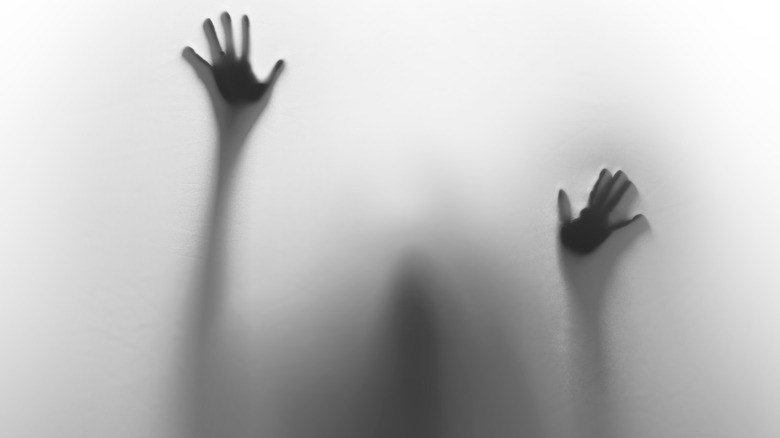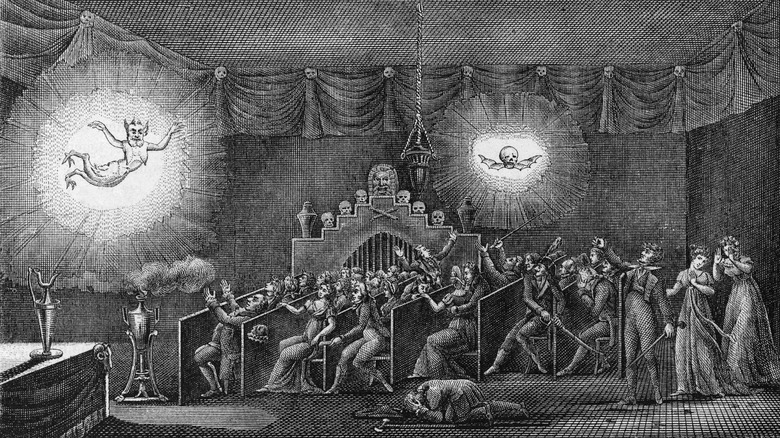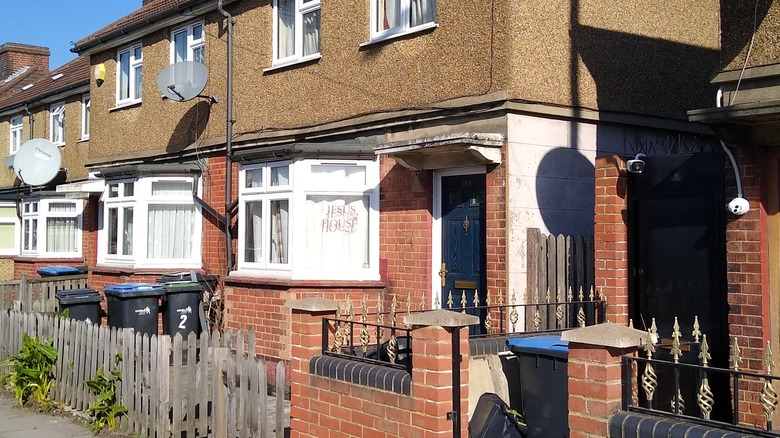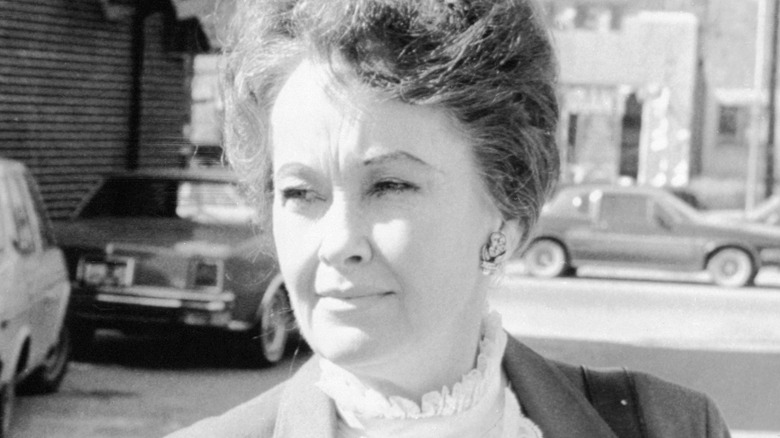What Is The Enfield Poltergeist?
You can find paranormal investigators in film, scripted television, and reality television, often up against fantastic displays of supernatural power or stretching a few bits of shaky footage into wild theories. But serious investigations of potential anomalous mental activity — be it psychics, precognition, out-of-body experiences, or hauntings — do exist, and earnest scientists involved in parapsychology have presented their efforts as genuine science in the face of skeptical opposition. The Society for Psychical Research (SPR) is the oldest body dedicated to paranormal investigations in Britain. Its members have probed a number of high-profile paranormal cases, including the Enfield poltergeist — later the subject of a fictionalized telling in "The Conjuring 2" and an Apple TV+ documentary.
It should be no surprise that the real Endfield poltergeist case was not part of a larger conspiracy of demon nuns. It began as a series of purported telekinetic events at the Hodgson home in Enfield, London, in 1977. According to People, furniture moving on its own in the children's bedroom progressed into spontaneous fires, objects levitating, voices from nowhere, and eventually, the periodic possession of younger daughter Janet Hodgson by the spirit of a man named Bill Wilkens, a proven former resident of the house. Alerted by the Daily Mirror to the phenomena, the SPR dispatched investigator Maurice Grosse, who became convinced that Enfield was a genuine haunting.
What is a poltergeist?
Per Britannica, the term "poltergeist" refers to a specific type of haunting — one involving inexplicable noises, objects moving on their own, and unpredictable episodes of violence. The phenomena tend to be associated with one member of a household, often a teenager, and the activity frequently stops when strangers come into the house. Per The Telegraph, when the Janet Hodgsons invited a photographer from the Daily Mirror into their Enfield home, nothing unusual happened until he was preparing to leave. The same happened when Maurice Grosse of the Society for Psychical Research (SPR) came to investigate. "Nothing happened for a while," he recalled years later, "But then I experienced Lego pieces flying across the room, and marbles. And the extraordinary thing was, when you picked them up they were hot, which is relevant to poltergeist-type activity."
The SPR considers poltergeist episodes to be "evidence suggestive of survival." That is to say, they are considered a potential indicator that some aspect of the human mind survives the death of the body. However, it's also been suggested that poltergeist phenomena are entirely generated by living individuals — specifically the person they seem most associated with. Notably, Italian paranormal researchers proposed that puberty triggers electron activity, which affects objects beyond the brain in a limited radius (per New Scientist). It's worth noting that this claim has been met with skepticism even among supporters of parapsychology.
And there is a third option to explain poltergeists: They all amount to hoaxes or delusions.
SPR investigators were divided over Enfield
While the Society for Psychical Research describes itself as a scientific organization and has working scientists of many disciplines among its leadership, many of its members do not have formal scientific backgrounds — including the two investigators most associated with the Enfield poltergeist case. Per his obituary from The Ghost Club, Maurice Grosse was originally a commercial artist with some design and engineering experience he turned toward invention later in life. He came by his interest in paranormal activity from personal tragedy and was more interested in investigations than theory. His fellow SPR member Guy Lyon Playfair, who became an enthusiastic supporter of the Enfield case, was an author and journalist whose mother had been a member of the SPR, per his obituary in The Telegraph.
Grosse and Playfair spent around six months investigating the Enfield case. Per The Telegraph, Grosse claimed to have seen huge pieces of furniture spin and fly about, coins materialize out of nowhere, and stones soar over the house (pictured above). He said that he heard dogs barking where there were no dogs and anomalous rapping inside the walls from several places at once. And he recorded what was supposedly Janet Hodgson channeling the voice of Bill Wilkens (via YouTube).
Grosse and Playfair were convinced by what they saw, but other SPR members who took an interest in the case were more skeptical. Researcher Anita Gregory wasn't shy about airing their doubts in SPR publications. While she entertained a paranormal origin from the Hodgsons themselves, she felt the case had devolved into a publicity-seeking enterprise (per the Skeptical Inquirer).
[Featured image by Mx. Granger via Wikimedia Commons | Cropped and scaled |CC0 1.0]
The Hodgson children faked some phenomena
Some of the skepticism SPR members held concerning the Enfield poltergeist case came down to the fact that the most spectacular claimed phenomena only happened when Janet Hodgson was around — and even then, only when not directly observed. Photographs of Hodgson supposedly being flung about her room by invisible hands were attributed to her gymnastics skills, and the strange voices and sounds to a possible talent for ventriloquism (per The Telegraph). Guy Lyon Playfair, despite ultimately accepting the haunting as genuine, maintained doubts about the affair and the honesty of Janet and her siblings.
The Hodgsons and Maurice Grosse both acknowledged after the fact that some of the phenomena in the Enfield house were faked. Hodgson told The Telegraph that she sometimes felt obliged to provide some "paranormal" activity when none was happening so she would be taken seriously, or to alleviate boredom. She told ITV that she and her siblings sometimes staged phenomena to see if the researchers would catch them, which they inevitably did (via the Daily Mail). For his part, Grosse accepted the occasional trick played by the children while maintaining that they couldn't have produced everything he saw. Hodgson herself maintains that her hoaxes amounted to a fraction of what went on in the Enfield house and insists that what happened to her was real.
The Amityville investigators did look into Enfield
The Enfield poltergeist case went on for 18 months, and the ordeal left Hodgson family matriarch Peggy Hodgson feeling drained and exploited (per the Daily Mail). Jane Hodgson left home at age 16 and stayed away from any debate and reanalysis of her experiences until after her mother died. Those debates, as might be expected, have involved a heavy amount of skepticism from outside observers. The Skeptic editor Deborah Hyde took to The Guardian to list known psychological processes that lead people to believe in things like hauntings when there's nothing really there. The skepticism of investigators who were on the scene has been noted as well — besides Anita Gregory of the Society for Psychical Research, magician Milbourne Christopher thought the whole affair an obvious case of a little girl's tricks (per the Skeptical Inquirer).
But Maurice Grosse and Guy Lyon Playfair weren't the only ones looking into Enfield who came away sure that something truly paranormal was going on. Ed and Lorraine Warren — the husband-wife paranormal investigation team that first looked into the Amityville case and who inspired "The Conjuring" series — visited Enfield during the alleged haunting and pronounced the whole thing genuine (per People). But ahead of the release of "The Conjuring 2," Playfair told Darkness Radio host Dave Schrader that the Warrens were only present for one uninvited day and, contrary to what the film portrayed, had almost nothing to do with the investigation (via Week in Weird).



